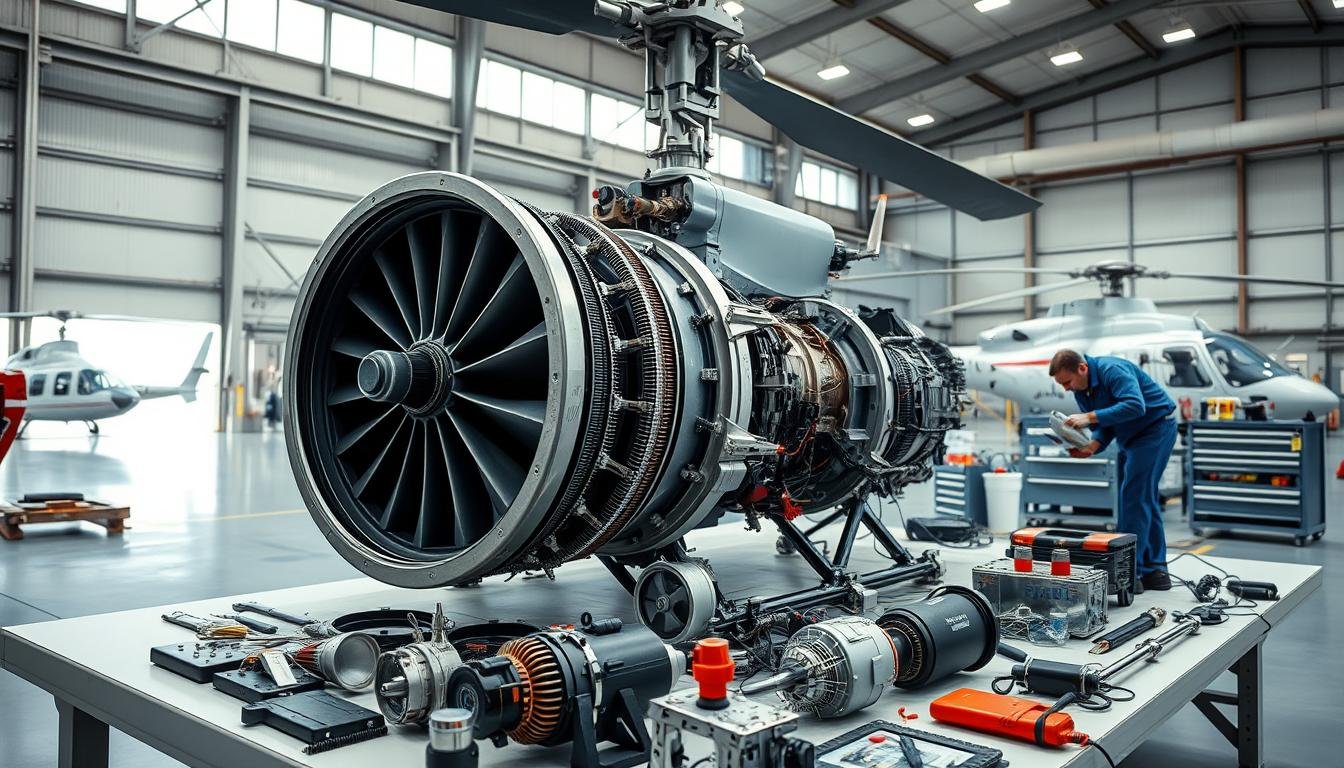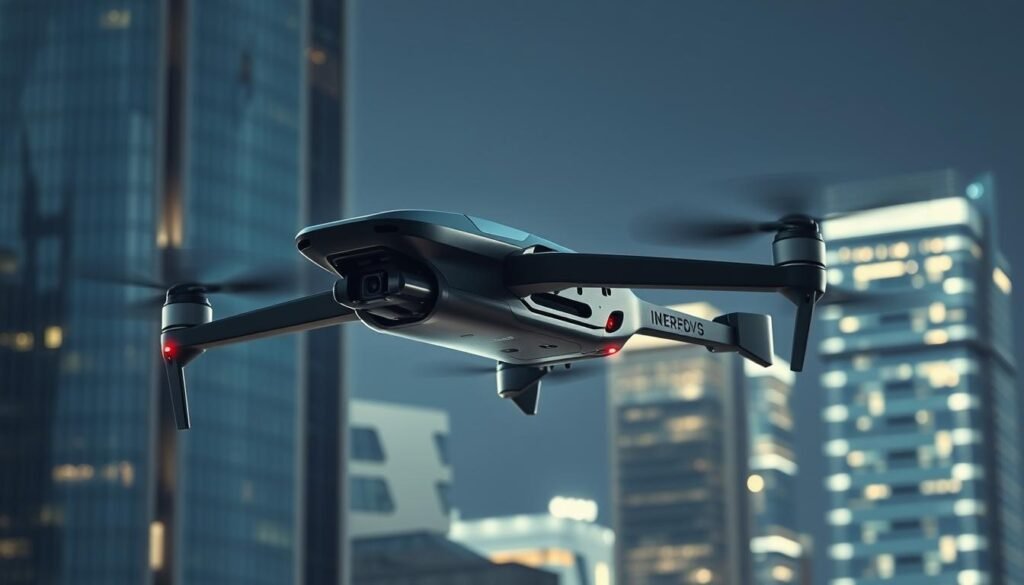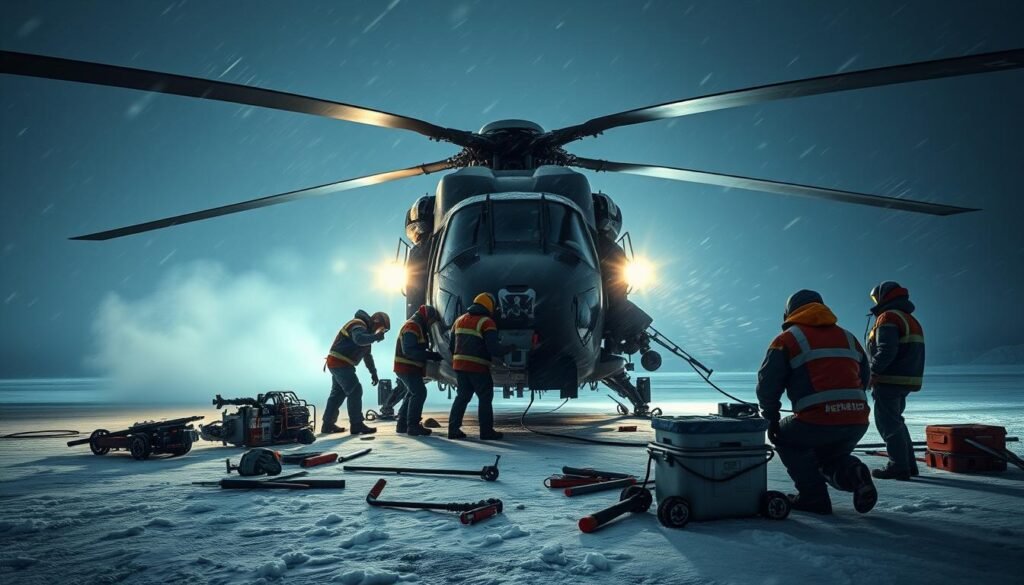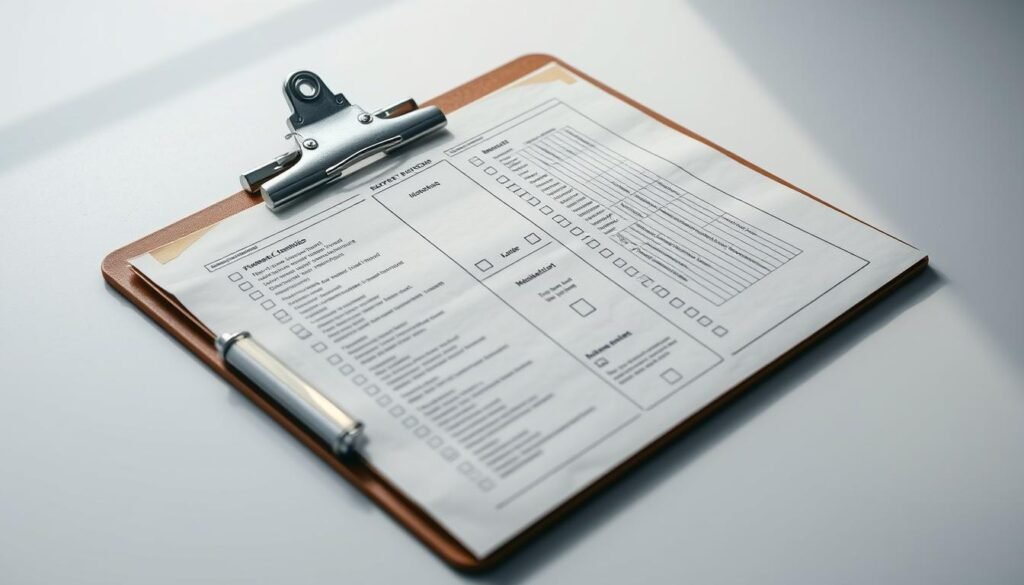Helicopter engine maintenance is more than routine care—it’s the key to extraordinary longevity. Well-kept aircraft can often reach 20,000–30,000 flight hours before requiring an overhaul, provided owners follow manufacturer recommendations and FAA guidance.
They learn that routine pre-flight checks of fuel and oil levels, timely oil changes around every 25 hours, and scheduled 100-hour inspections are practical steps that reduce risk.
Good records prove compliance, help diagnose trends, and keep operations aligned with regulatory requirements and manufacturer tasks.
The industry expects a program approach that ties scheduled tasks, unscheduled repairs, and qualified personnel together to sustain safety and availability.

For a full guide on intervals and detailed procedures, readers can consult the detailed resource at manufacturer and FAA best practices.
Key Takeaways
- Follow manufacturer requirements and FAA rules as the foundation of any program.
- Routine checks of fuel, oil, filters, and cooling systems catch issues early.
- Keep accurate records to demonstrate continuous airworthiness and track trends.
- Qualified personnel using approved procedures ensure repairs are done right.
- Proper care can extend service life toward the commonly cited overhaul window.
Foundations For Safe, Compliant Helicopter Engine Maintenance In The United States
They begin with a program. A clear plan ties manufacturer manuals to FAA requirements and to credentialed service providers. This approach protects certification, supports safety, and creates traceable work records.
Follow Manufacturer Guidance And FAA Requirements
Follow manufacturer instructions and FAA rules because certification and airworthiness hinge on approved tasks, limits, and documented procedures. Owners should confirm work is done at a certified 145 Repair Station or an Authorized Service Center when complexity or warranty rules require it.
Limited Part 43 tasks can be signed by qualified A&P mechanics for eligible aircraft, but many repairs route through centers like USATS for Robinson R22/R44 to keep standards and traceability intact.
Know Your Engine Types And Their Maintenance Implications
Most modern helicopters use turboshaft powerplants; smaller training aircraft may use reciprocating units. Each type has different components, inspection intervals, and rotor-drive implications.
- Plan parts, fluids, and inspections around the specific engine type.
- Use approved torque values, calibrations, and procedures to improve safety.
- Work with authorized facilities to preserve certification and records.
Operators who apply the right requirements to their airframe and powerplant avoid generic advice that might not fit their aircraft or operational profile. For industry safety standards and private-aviation guidance, consult this resource on setting safety standards in private aviation: setting the standard for safety.
Helicopter Engine Maintenance How-To: Inspections, Schedules, Repairs, And Records
A disciplined pre-flight routine is the best single habit to reduce unscheduled downtime. Short, repeatable checks protect safety and keep crews mission-ready.

Make Pre-Flight Inspections A Non-Negotiable Routine
They should inspect cabin condition, visible engine area, and rotors before every flight. Check fuel and oil levels, confirm the ignition is off, and verify tire condition.
Remove frost, ice, or snow and confirm paperwork is aboard. Small finds in pre-flight inspections prevent larger repairs later.
Set And Follow Scheduled Maintenance By Hours And Calendar Time
Operators set a clear schedule that tracks hours and calendar time. Oil changes near every 25 hours and 100-hour inspections are common, but the schedule must match the manufacturer and the aircraft’s maintenance needs.
Log hours flight and calendar triggers so no item becomes overdue.
Act On Unscheduled Issues And Repairs Without Delay
Small issues become big problems if left alone. Technicians should act quickly and use approved procedures to limit downtime.
Prompt repairs reduce cascade failures and lower total repair costs.
Maintain Clear, Concise, And Auditable Maintenance Records
Records must state what work was done, when, by whom, and which parts were used. Good logs reveal trends in condition and support compliance with manufacturer and FAA requirements. Well-kept records make audits straightforward.
Protect The Aircraft With Proper Storage And Handling
Hangar storage limits environmental wear, corrosion, and contamination. Proper handling between flights preserves components and extends service life.
| Task | Trigger | Who | Notes |
|---|---|---|---|
| Pre-flight Inspection | Before Every Flight | Pilot/Technician | Cabin, rotors, fuel, oil, tires, paperwork |
| Oil Change | ~25 Hours | Technician | Use manufacturer-approved oil and filter |
| Comprehensive Check | 100 Hours / Calendar | Authorized Shop | Follow manufacturer intervals and limits |
| Unscheduled Repair | As Needed | Qualified Technician | Document work with part numbers and signatures |
“Technicians should watch for sounds, temperature shifts, and vibration to catch issues early.”
For a full program that ties scheduled work to regulatory guidance, review the manufacturer and FAA best practices.
Power Assurance, Trend Monitoring, And Cost Planning For Engine Longevity
A data-driven approach to power output and condition trends keeps airworthiness predictable and budgets steady. Operators use Power Assurance Checks (PACs) and Engine Condition Trend Monitoring (ECTM/HECTM) to compare live performance to baseline curves. This helps catch degradations early and target inspections instead of guessing.

Use Power Assurance Checks And Engine Condition Trend Monitoring
PACs and trend logging supply the data needed to validate power and detect shifts in compressor or turbine sections. Teams compare curves to baselines and flag signatures that indicate wear or contamination.
When trends change, technicians can stage targeted inspections and avoid broad, reactive work. For industry methods and case studies, review the trend monitoring research linked below.
Leverage Qualified Repair Stations, Part 43 Services, And Authorized Centers
Certified 145 Repair Stations and Authorized Service Centers use approved tooling and procedures to interpret trend data and perform repairs. Limited Part 43 services remain useful for smaller tasks signed by A&P mechanics.
Using the right facility preserves certification and speeds repairs through proper documentation and alignment with manufacturers.
Budget For Turboshaft Shop Visits, Parts, And Labor
Plan realistic costs: turboshaft shop visits commonly run $100,000–$300,000 per unit, covering inspection, parts, labor, transport, and short-term leases to sustain operations.
Build overhaul windows, turnaround time, and parts lead times into the maintenance program. Working with established parts distributors shortens delays and lowers total downtime.
“A cost-aware, data-led program keeps rotors turning reliably while managing risk and certification.”
For practical program tools and checklists, operators can consult a trends resource at power and trends guidance, a technical paper on monitoring at trend monitoring study, and a routine checklist at routine inspection checklist.
Conclusion
Operators gain clear value from a disciplined program that ties hours, trend data, and qualified technicians together. Well-executed care aligned with FAA and manufacturer guidance can extend service toward the commonly cited 20,000–30,000 hours before overhaul.
Consistent pre-flight checks, scheduled tasks, prompt work, and accurate records keep helicopters ready for safe flight. A realistic schedule informed by trends makes tasks predictable and less disruptive.
The industry message is simple: do the work on time, document it, and act on findings. For a concise guide on why this matters to long service life, see maintenance key for longevity.
FAQ
What are the most important actions to extend service life and reliability?
They should follow manufacturer service bulletins and FAA airworthiness directives, stick to scheduled inspections by hours and calendar time, and perform consistent preflight checks. Using OEM-approved lubricants, monitoring oil and fuel condition, and addressing minor discrepancies promptly prevents larger failures and reduces overhaul frequency.
How often must technicians perform scheduled inspections?
Inspection intervals depend on the specific model and engine type; many programs require checks at set flight-hour blocks and periodic calendar milestones. Operators should use the manufacturer maintenance manual and FAA 14 CFR guidance to build a compliance schedule and track hours through logbooks and digital records.
What should be included in a preflight inspection routine?
A preflight should verify fuel quantity and quality, oil level and contamination, visible leaks, air intake and exhaust condition, accessory drive integrity, and rotor-system clearances. Any unusual noises, vibrations, or warning indications must be reported before flight.
When is an unscheduled shop visit required?
A shop visit is required after events such as abnormal power loss, foreign object damage, elevated vibration levels, or if condition-monitoring trends exceed limits. Operators should remove the powerplant from service for detailed inspection when in-flight parameters or ground-based checks indicate potential internal damage.
How do trend monitoring and power assurance checks improve safety?
Regular trend analysis of parameters like torque, interstage temperatures, and fuel flow detects gradual degradation before it becomes critical. Power assurance runs replicate operational loads to confirm performance margins and validate repairs, reducing the risk of in-flight power loss.
Who is authorized to perform repairs and overhauls?
Only certificated repair stations, FAA Part 145 facilities, or manufacturer-authorized centers should perform major work and overhauls. Certified A&P mechanics and technicians with specific engine type ratings must sign off inspections and return-to-service paperwork per regulatory requirements.
What records must operators keep and for how long?
Operators must retain maintenance logs, work orders, compliance with Airworthiness Directives, and parts traceability documents. The FAA requires that maintenance records remain with the aircraft and be available for inspection; retention periods vary by item but key entries should be kept for the life of the airframe or as specified in regulations.
How should parts be handled to avoid premature failure?
Use only parts with proper traceability and approved serial numbers, store components in controlled environments, follow torque and installation procedures, and keep contaminants out of fuel and oil systems. Handling procedures and storage minimize corrosion, seal degradation, and foreign object damage.
What cost factors should operators budget for over the life cycle?
Budget for routine inspections, periodic shop visits, consumables like filters and oils, life-limited parts, and unscheduled repairs. Turboshaft shop visits and OEM overhauls represent major cost centers; proactive condition monitoring and timely repairs lower total cost of ownership over time.
How should operators choose a maintenance program?
Select a program that aligns with the airworthiness standards, manufacturer recommendations, and operational profile. Programs should include scheduled inspections, condition-based monitoring, clear record-keeping, and defined escalation for unscheduled events. Working with experienced maintenance providers ensures compliance and operational readiness. practices such as regular inspections, adhering to manufacturer guidelines, maintaining the fuel and cooling systems, and monitoring engine performance, pilots and maintenance crews can keep helicopter engines running smoothly and safely. Routine maintenance not only enhances the reliability of the engine but also improves flight safety and operational efficiency.
Related Articles
- Understanding Helicopter Vibration Analysis: Key to Preventing Major Failures
- How AI and Big Data Are Shaping the Future of Helicopter Maintenance
- Upgrading Helicopter Systems: When and Why to Modernize Your Aircraft
- The Importance of Regular Avionics Checks for Helicopter Performance
- Helicopter Maintenance in Extreme Weather Conditions: What Technicians Need to Know
More from This Category
- Digital Cockpits: How Modern Technology Is Transforming Helicopter Navigation
- The Role of Predictive Maintenance in Helicopter Fleet Management
- Innovative Materials in Helicopter Design: Enhancing Durability and Efficiency
- How Helicopter Technology Is Revolutionizing Emergency Response Operations
- Rotor Blade Maintenance: Why It’s Critical for Safe Flight
- The Future of Autonomous Helicopters: What Technology Holds for the Aviation Industry
- Helicopter Engine Maintenance: Best Practices for Longevity and Efficiency
- How Advances in Avionics Are Improving Helicopter Safety and Performance
- Routine Helicopter Maintenance Checklist: What Every Pilot Should Know
- The Evolution of Helicopter Technology: From Early Models to Modern Innovations



